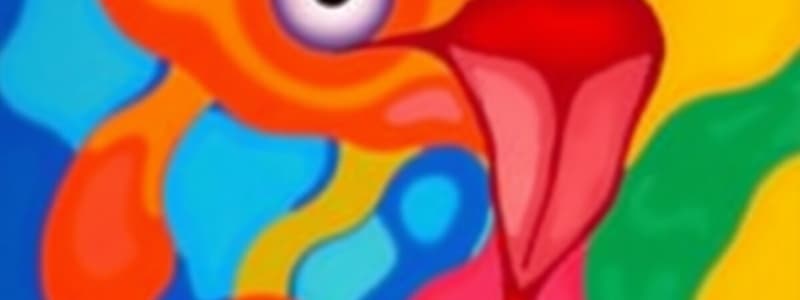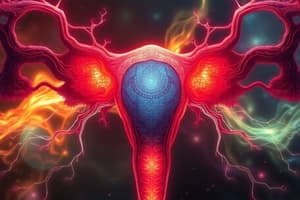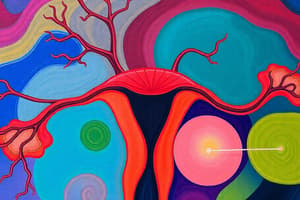Podcast
Questions and Answers
What is the primary function of the ductus deferens?
What is the primary function of the ductus deferens?
- To transport sperm from the epididymis to the ejaculatory duct (correct)
- To produce seminal fluid
- To store and mature sperm
- To serve as a birth canal
Which phase of the menstrual cycle is primarily responsible for ovarian follicle maturation?
Which phase of the menstrual cycle is primarily responsible for ovarian follicle maturation?
- Follicular Phase (correct)
- Ovulatory Phase
- Luteal Phase
- Menstrual Phase
What structure is formed when the ductus deferens merges with the seminal vesicle?
What structure is formed when the ductus deferens merges with the seminal vesicle?
- Prostate gland
- Vas deferens
- Urethra
- Ejaculatory duct (correct)
Where does fertilization typically occur within the female reproductive system?
Where does fertilization typically occur within the female reproductive system?
Which components contribute to seminal vesicle secretion?
Which components contribute to seminal vesicle secretion?
What is the primary function of the ductus deferens during ejaculation?
What is the primary function of the ductus deferens during ejaculation?
What role does the ejaculatory duct serve in the male reproductive system?
What role does the ejaculatory duct serve in the male reproductive system?
What is a key component of the secretion from the seminal vesicles?
What is a key component of the secretion from the seminal vesicles?
What protective function does the bulbourethral glands' secretion provide?
What protective function does the bulbourethral glands' secretion provide?
Which structure surrounds the first inch of the urethra and contributes to semen expulsion?
Which structure surrounds the first inch of the urethra and contributes to semen expulsion?
How many chromosomes does the head of a sperm contain?
How many chromosomes does the head of a sperm contain?
In what structure do sperm complete their maturation?
In what structure do sperm complete their maturation?
What describes the composition of the prostate's secretion?
What describes the composition of the prostate's secretion?
What is the primary role of the ductus deferens in the male reproductive system?
What is the primary role of the ductus deferens in the male reproductive system?
What initiates the growth of ovarian follicles during oogenesis?
What initiates the growth of ovarian follicles during oogenesis?
Which structure connects the seminiferous tubules to the ejaculatory duct?
Which structure connects the seminiferous tubules to the ejaculatory duct?
Where does fertilization of the egg typically occur?
Where does fertilization of the egg typically occur?
What is one of the main components secreted by the seminal vesicles?
What is one of the main components secreted by the seminal vesicles?
What hormone is responsible for promoting the maturation of the ovum during oogenesis?
What hormone is responsible for promoting the maturation of the ovum during oogenesis?
What forms after fertilization of the secondary oocyte?
What forms after fertilization of the secondary oocyte?
During which phase of the menstrual cycle is a mature ovum typically released?
During which phase of the menstrual cycle is a mature ovum typically released?
What is the primary function of the mammary glands during lactation?
What is the primary function of the mammary glands during lactation?
What initiates the preparation of mammary glands for milk production during pregnancy?
What initiates the preparation of mammary glands for milk production during pregnancy?
Which term describes the condition where the prostate enlarges and may lead to urinary difficulties?
Which term describes the condition where the prostate enlarges and may lead to urinary difficulties?
During which phase of the menstrual cycle does the shedding of the uterine lining occur?
During which phase of the menstrual cycle does the shedding of the uterine lining occur?
What is the typical age range for the occurrence of prostate cancer in men?
What is the typical age range for the occurrence of prostate cancer in men?
What role does the acrosome of the sperm serve?
What role does the acrosome of the sperm serve?
Which gland produces a secretion that neutralizes acidic urine just before ejaculation?
Which gland produces a secretion that neutralizes acidic urine just before ejaculation?
Which structure is responsible for transporting sperm from the epididymis into the abdominal cavity?
Which structure is responsible for transporting sperm from the epididymis into the abdominal cavity?
The secretion from which of these glands provides fructose for sperm energy?
The secretion from which of these glands provides fructose for sperm energy?
What is the function of the corpus luteum after ovulation?
What is the function of the corpus luteum after ovulation?
What feature of the ductus deferens aids in the propulsion of sperm during ejaculation?
What feature of the ductus deferens aids in the propulsion of sperm during ejaculation?
What is the function of the alkaline secretion produced by the prostate gland?
What is the function of the alkaline secretion produced by the prostate gland?
Which structure is responsible for the peristaltic movement of the ovum towards the uterus?
Which structure is responsible for the peristaltic movement of the ovum towards the uterus?
What primarily controls the process of ovulation?
What primarily controls the process of ovulation?
Which part of the male reproductive system is coiled and plays a crucial role in sperm maturation?
Which part of the male reproductive system is coiled and plays a crucial role in sperm maturation?
What is the primary role of the glans penis?
What is the primary role of the glans penis?
What is the typical survival time of an unfertilized ovum in the female reproductive system?
What is the typical survival time of an unfertilized ovum in the female reproductive system?
What is the role of fimbrae in the female reproductive system?
What is the role of fimbrae in the female reproductive system?
What is the consequence of anegg cell undergoing oogenesis?
What is the consequence of anegg cell undergoing oogenesis?
What components make up semen?
What components make up semen?
What happens to the primary ovarian follicles that do not mature?
What happens to the primary ovarian follicles that do not mature?
What role does FSH play in spermatogenesis?
What role does FSH play in spermatogenesis?
What is the average pH of semen?
What is the average pH of semen?
What is the primary difference between spermatogenesis and oogenesis?
What is the primary difference between spermatogenesis and oogenesis?
What is the optimal temperature for sperm production in the testes?
What is the optimal temperature for sperm production in the testes?
What initiates the production of testosterone in the male reproductive system?
What initiates the production of testosterone in the male reproductive system?
How does the secretion of inhibin affect FSH levels?
How does the secretion of inhibin affect FSH levels?
What happens to the secondary oocyte during fertilization?
What happens to the secondary oocyte during fertilization?
What triggers the cyclical production of a mature ovum in females?
What triggers the cyclical production of a mature ovum in females?
Flashcards
Functions of the vagina
Functions of the vagina
The vagina receives sperm, is the exit for menstrual blood flow, and serves as the birth canal.
Normal vaginal flora
Normal vaginal flora
Creates an acidic environment that prevents harmful bacteria growth.
Prostatic Hypertrophy
Prostatic Hypertrophy
Enlargement of the prostate gland, commonly affecting men over 60, potentially causing urination issues.
Prostate Cancer Treatment
Prostate Cancer Treatment
Signup and view all the flashcards
Mammary Glands Function
Mammary Glands Function
Signup and view all the flashcards
Sperm Head Components
Sperm Head Components
Signup and view all the flashcards
Sperm Middle Piece
Sperm Middle Piece
Signup and view all the flashcards
Sperm Flagella Function
Sperm Flagella Function
Signup and view all the flashcards
Epididymis Function
Epididymis Function
Signup and view all the flashcards
Ductus Deferens Function
Ductus Deferens Function
Signup and view all the flashcards
Seminal Vesicles Secretion
Seminal Vesicles Secretion
Signup and view all the flashcards
Prostate Gland Function
Prostate Gland Function
Signup and view all the flashcards
Urethra's Role in Semen
Urethra's Role in Semen
Signup and view all the flashcards
Spermatogenesis
Spermatogenesis
Signup and view all the flashcards
Oogenesis
Oogenesis
Signup and view all the flashcards
Meiosis
Meiosis
Signup and view all the flashcards
Gametes
Gametes
Signup and view all the flashcards
Testes
Testes
Signup and view all the flashcards
Seminiferous Tubules
Seminiferous Tubules
Signup and view all the flashcards
FSH
FSH
Signup and view all the flashcards
Ovaries
Ovaries
Signup and view all the flashcards
Spermatogenesis
Spermatogenesis
Signup and view all the flashcards
Oogenesis
Oogenesis
Signup and view all the flashcards
Meiosis
Meiosis
Signup and view all the flashcards
Gametes
Gametes
Signup and view all the flashcards
Testes Location
Testes Location
Signup and view all the flashcards
Seminiferous Tubules
Seminiferous Tubules
Signup and view all the flashcards
FSH
FSH
Signup and view all the flashcards
Ovaries
Ovaries
Signup and view all the flashcards
Sperm Head Components
Sperm Head Components
Signup and view all the flashcards
Sperm Middle Piece Function
Sperm Middle Piece Function
Signup and view all the flashcards
Epididymis Role
Epididymis Role
Signup and view all the flashcards
Ductus Deferens Path
Ductus Deferens Path
Signup and view all the flashcards
Seminal Vesicle Secretion
Seminal Vesicle Secretion
Signup and view all the flashcards
Prostate Gland Function
Prostate Gland Function
Signup and view all the flashcards
Urethra's Role in Ejaculation
Urethra's Role in Ejaculation
Signup and view all the flashcards
Penis Function
Penis Function
Signup and view all the flashcards
Penis Erection
Penis Erection
Signup and view all the flashcards
Semen Composition
Semen Composition
Signup and view all the flashcards
Ovary Function
Ovary Function
Signup and view all the flashcards
Ovulation
Ovulation
Signup and view all the flashcards
Fallopian Tube Function
Fallopian Tube Function
Signup and view all the flashcards
Uterus Structure
Uterus Structure
Signup and view all the flashcards
Vaginal Structure
Vaginal Structure
Signup and view all the flashcards
Corpus Luteum
Corpus Luteum
Signup and view all the flashcards
Vagina's Function
Vagina's Function
Signup and view all the flashcards
Prostate Enlargement
Prostate Enlargement
Signup and view all the flashcards
Prostate Cancer Treatment
Prostate Cancer Treatment
Signup and view all the flashcards
Menstrual Cycle Length
Menstrual Cycle Length
Signup and view all the flashcards
Mammary Gland Function
Mammary Gland Function
Signup and view all the flashcards
Study Notes
Reproductive Systems
- The reproductive systems enable continuation of the human species by producing offspring.
- Male and female reproductive systems create gametes (sperm and egg cells) and ensure their union during fertilization.
Meiosis
- Meiosis produces gametes.
- One cell with a diploid chromosome number (46) divides twice to produce four cells, each with a haploid chromosome number (23).
Spermatogenesis
- Occurs in the testes.
- Seminiferous tubules contain spermatogonia (sperm-generating cells).
- Follicle-stimulating hormone (FSH) initiates sperm production.
- Testosterone, stimulated by luteinizing hormone, promotes maturation of sperm.
- Inhibin decreases FSH secretion.
- For each primary spermatocyte that undergoes meiosis, four functional sperm cells form.
- Sperm production begins at puberty and continues throughout life.
- Millions of sperm are produced daily.
Oogenesis
- Oogenesis is the process of egg cell formation, through meiosis.
- This process happens in the ovaries.
- It's regulated by hormones.
- Follicle-stimulating hormone (FSH) stimulates the growth of ovarian follicles which contain oogonium or egg generating cells.
- FSH stimulates follicle cells to secrete estrogen that, in turn, promotes maturation of ovum.
- One primary oocyte produces one functional egg, and three polar bodies.
- Ovum production starts at puberty and continues until menopause.
- A mature ovum is produced roughly every 28 days.
Testes
- Located in the scrotum, a sac between the thighs.
- Temperature is 96 degrees, slightly lower than body temperature, for sperm production.
- During fetal development, testes develop near the kidneys, and descend into the scrotum before birth.
- Testes are divided into lobes, each with seminiferous tubules where spermatogenesis takes place.
Epididymis
- A 20-foot long, coiled tube on the posterior side of each testis.
- Sperm mature and gain motility here.
- Smooth muscle propels sperm into the ductus deferens.
Ductus Deferens
- Also called vas deferens.
- Extends from the epididymis into the abdominal cavity through the inguinal canal.
- The inguinal canal is a weak spot that can be a site of hernia formation.
- Inside the abdominal cavity, the ductus deferens travels over and down the urinary bladder to join with the ejaculatory duct.
- Smooth muscles in the ductus deferens contract to help expel sperm during ejaculation.
Ejaculatory Ducts
- Receive sperm from the ductus deferens and secretions from the seminal vesicle.
- Empty into the urethra.
Seminal Vesicles
- Located behind the bladder.
- Secrete fluid containing fructose, an energy source for sperm, and alkaline properties to enhance sperm motility.
- Each duct joins the ductus deferens on the same side forming the ejaculatory duct.
Prostate
- Muscular gland below the bladder.
- Surrounds the urethra.
- Glandular tissue releases an alkaline fluid that maintains sperm motility.
- Prostate smooth muscles help with expulsion of semen.
Bulbourethral Glands
- Also called Cowper's glands.
- Located below the prostate gland and empty into the urethra.
- Secrete an alkaline fluid that coats the urethra before ejaculation to neutralize acidic urine.
Urethra-Penis
- The urethra is the final duct for semen travel.
- It's primarily found within the penis.
- The distal end of the penis is called the glans penis.
- The penis is covered with skin called the foreskin.
Semen
- Semen consists of sperm and secretions from the seminal vesicles, prostate, and bulbourethral glands.
- The pH of semen is about 7.4.
- 2–4 mL of semen are expelled, with each mL containing around 100 million sperm cells.
Female Reproductive System
- Ovaries are paired oval structures, about 1.5 inches long.
- They are located on either side of the uterus in the pelvic cavity.
- Broad ligaments keep ovaries in position.
- Several hundred thousand primary follicles are present at birth; about 300–400 mature.
- Each follicle contains an oocyte (a potential egg cell).
- Follicle cells secrete estrogen.
- A graafian follicle is a mature follicle.
- LH triggers ovulation or follicle rupture, releasing the ovum.
Fallopian Tubes
- 4 inches long.
- Lateral end surrounds the ovary.
- Fimbriae creates currents in the fluid to pull ovum into the tube.
- The medial end opens into the uterus.
- Smooth muscles cause peristalsis, moving the ovum.
- Ciliated mucosa sweeps the ovum to the uterus.
- Fertilization occurs inside the fallopian tubes.
- If not fertilized, ovum dies within 24–48 hours and disintegrates.
- Fertilized ovum becomes a zygote and travels to the uterus (4–5 days).
- Ectopic pregnancy occurs when implantation happens outside of the uterus.
Uterus
- 3 inches long by 2 inches wide.
- Superior to the bladder, between the ovaries in the pelvic cavity.
- Broad ligaments cover the uterus.
- Composed of fundus, body, and cervix.
- Myometrium is the muscular layer, and endometrium is the inner lining divided into functional and basal layers.
Vagina
- Muscular tube about 4 inches in length.
- Extends from the cervix to the vaginal orifice in the perineum (pelvic floor).
- Posterior to the urethra and anterior to the rectum.
- Partially covered with the hymen.
- Serves as receiving area for sperm.
- Exit for menstrual blood flow and the birth canal.
External Genitals
- Another name for the vulva.
- Include the clitoris, labia majora, labia minora, and Bartholin's glands.
Mammary Glands
- Produce milk to nourish offspring.
- Composed of glandular tissue surrounded by adipose tissue.
- Alveolar glands create milk after pregnancy.
- Milk travels through lactiferous ducts to the nipple.
- The areola is pigmented skin surrounding the nipple.
- Estrogen and progesterone prepare glands for milk production.
Menstrual Cycle
- A 28-day cycle.
- Phases include menstrual, follicular, and luteal.
- Amenorrhea can be related to insufficient body fat.
Additional Conditions
- Prostatic hypertrophy is an enlargement of the prostate common in men over 60 years old.
- A prostatectomy is the surgical removal of part or all of the prostate.
- Cancer of the prostate is a common cancer in men over 50
Studying That Suits You
Use AI to generate personalized quizzes and flashcards to suit your learning preferences.




